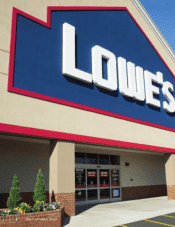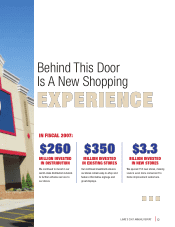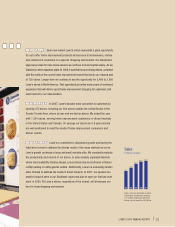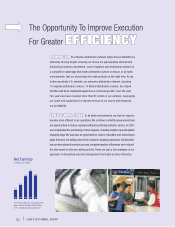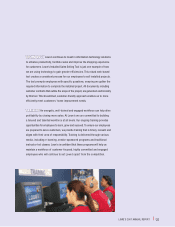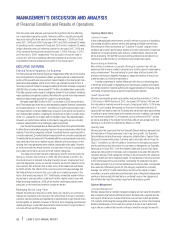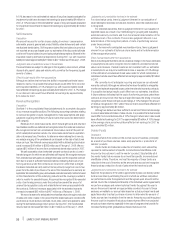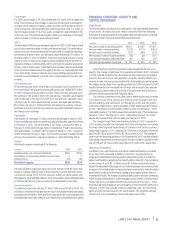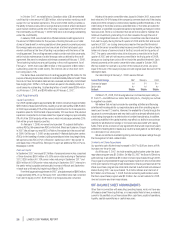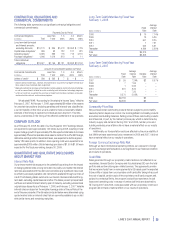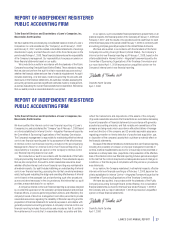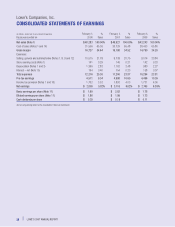Lowe's 2007 Annual Report Download - page 20
Download and view the complete annual report
Please find page 20 of the 2007 Lowe's annual report below. You can navigate through the pages in the report by either clicking on the pages listed below, or by using the keyword search tool below to find specific information within the annual report.18 |LOWE’S 2007 ANNUAL REPORT
This discussion and analysis summarizes the significant factors affecting
our consolidated operating results, financial condition, liquidity and capital
resources during the three-year period ended February 1, 2008 (our fiscal
years 2007,2006 and 2005).Fiscal years 2007 and 2006 contained 52 weeks
of operating results, compared to fiscal year 2005 which contained 53 weeks.
Unless otherwise noted, all references herein for the years 2007, 2006 and
2005 represent the fiscal years ended February 1, 2008, February 2, 2007,
and February 3, 2006, respectively. This discussion should be read in
conjunction with the consolidated financial statements and notes to the
consolidated financial statements included in this annual report.
EXECUTIVE OVERVIEW
External Factors Impacting Our Business
The home improvement market is large and fragmented.While we are the world’s
second-largest home improvement retailer,we have captured a relatively small
portion of the overall home improvement market.Based on the most recent com-
prehensive data available,which is from 2006,we estimate the size of the U.S.
home improvement market to be approximately $755 billion annually,comprised
of $585 billion of product demand and $170 billion of installed labor opportunity.
This data captures a wide range of categories relevant to our business,including
major appliances and garden supplies.We believe the current home improvement
market provides ample opportunity to support our growth plans.
Net sales totaled $48.3 billion in 2007,an increase of 2.9% versus the prior
year.Thisincreasewasdrivenbyourstoreexpansionprogram.However,comparable
store sales declined 5.1% in 2007.The effects of a soft housing market,tight
mortgage market, continued deflationary pressures from lumber and plywood,
and unseasonable weather, including the exceptional drought in certain areas
of the U.S.,pressured our industry and contributed to lower than expected sales.
However, our performance relative to the industry suggests we are providing
customer-valued solutions in a challenging sales environment.
Overthepastseveralquarterswehaveused third-partyhomepriceinformation
todefine three broad marketgroupingsbasedonhome price dynamicswithin those
markets.These three categories included 1) markets that are overpriced with a
correction expected,2) markets thatare overpriced with no correctionexpected and
3)marketsthatarenotoverpriced.Themarketswith the mostovervaluedhomeprices
have generated the worst relative results. Markets with less impact on the
housing front have generated better relative comparable store sales.However,
as we have monitored these markets, we have seen erosion in comparable
store sales performance across all three market categories.
The sales environment remains challenging, and the external pressures
facing our industry will continue in 2008.We will continue to monitor the
structural drivers of demand including housing turnover, employment and
personal disposable income, as well as consumer sentiment related to home
improvement.We anticipate that at least some of the headwinds will lessen
as 2008 unfolds.The effects of the recent economic stimulus package and
the Federal Reserve interest rate cuts could aid in stabilizing many of the
factors that pressured sales in 2007.Additionally, normalized weather follow-
ing last year’s unusual pattern could lead to better relative results. Even with
these lessening headwinds, 2008 will be another challenging year as many
pressures on the home improvement consumer remain.
Managing for the Long-Term
Despite the external pressures currently facing our industry,we continue to
manage our business for the long-term.We will continue to focus on providing
customer-valued solutions and capitalizing on opportunities to gain market share
and strengthen our business. However, in the short-term managing expenses and
capital spending is crucial.We have and will continue to look for opportunities to
cut costs without sacrificing customer service.
Capturing Market Share
Customer-Focused
In this challenging sales environment, we will continue to pursue our disciplines
of providing excellent customer service and gaining profitable market share.
We continue to refine and improve our “Customer-Focused” program which
measures each store’s performance relative to five key components of customer
satisfaction, including selling skills, delivery, installed sales, checkout and
phone answering.The fact that we are providing great service and value to our
customers is evidenced by our continued strong market share gains.
Merchandising and Marketing
We continue to enhance our product offerings to customers but with an
awareness that in many markets customers are more focused on maintenance
versus enhancement.They are looking for great value at all price points.We
are also continuing to diligently manage our seasonal inventory to ensure we
maximize sales, but minimize markdowns.
A similar awareness of market differences will drive our advertising plan
in 2008.We are focused on highlighting key maintenance projects and inexpen-
sive enhancements in markets suffering the biggest slowdown in housing,while
continuing to highlight larger projects in less impacted markets.
Growth Opportunities
We have considerable growth opportunities and see the potential for 2,400 to
2,500 stores in NorthAmerica.In 2007, we opened 153 stores (149 new and
four relocated) in markets around the country,bringing our total to 1,534 stores
in the U.S.and Canada.We opened our first store in the state of Vermont in
January.We now have stores in all 50 states,and we still see many opportunities
to continue to grow market share in the markets we serve.In addition,we opened
our first stores outside the U.S.in December, and,as of the end of 2007,we had
six stores operating in the Greater Toronto Area.We are also preparing for the
opening of our first stores in Monterrey, Mexico, in 2009.
Specialty Sales
We recognize the opportunity that our Specialty Sales initiatives represent and
the importance of these businesses to our long-term growth.Our Specialty
Sales initiatives include three major categories: Installed Sales, Special Order
Sales and Commercial Business Customer sales, internally referred to as the
“Big 3.”In addition, our effort to utilize e-Commerce to drive sales and conve-
niently provide product information to customers is managed by our Specialty
Sales group. In fiscal 2007,both the Installed Sales and Special Order Sales
categories had growth in total sales, but comparable store sales fell below the
company average.These categories continue to be pressured by the weakness
in bigger-ticket and more complex projects.This weakness is more pronounced
in the most pressured housing markets.Contrasting the weakness has been
the relative strength in our Commercial Business Customer sales. Comparable
store sales and total sales growth for this category outpaced the company
average. Our efforts to build relationships and serve the needs of repair/
remodelers,property maintenance professionals,and professional tradespeople
continue to drive results.We feel that our continued focus on the categories of
this initiative that have the greatest opportunity will produce growth.
Expense Management
Centralized Management
We have always been a centrally managed company,and we value the discipline
and consistency that comes with that structure.We have built a regional and dis-
trict support infrastructure to ensure that occurs.As we have further penetrated
U.S.markets,shortening the average distance between our stores,the shortened
distance has allowed us to increase the number of stores in each district and
region.We are confident that we will continue to have the oversight we need to
MANAGEMENT’S DISCUSSION AND ANALYSIS
of Financial Condition and Results of Operations


